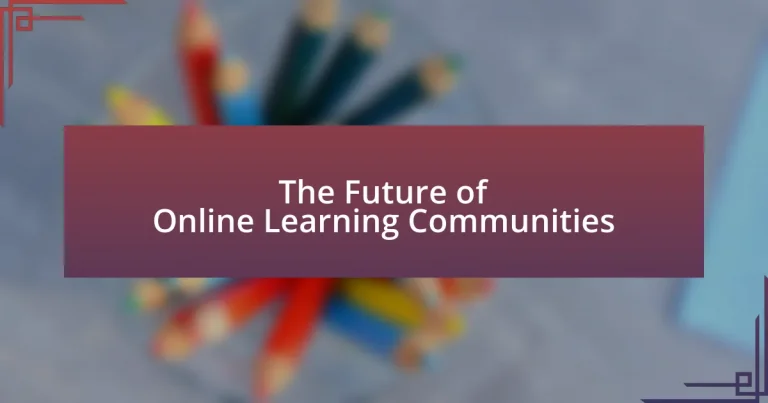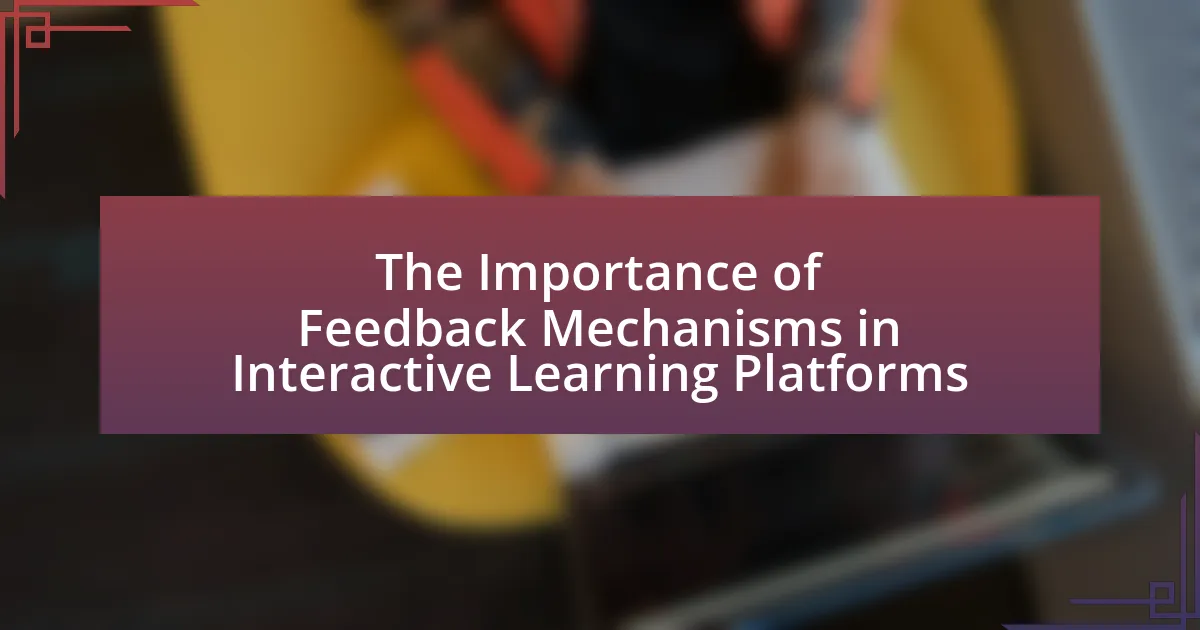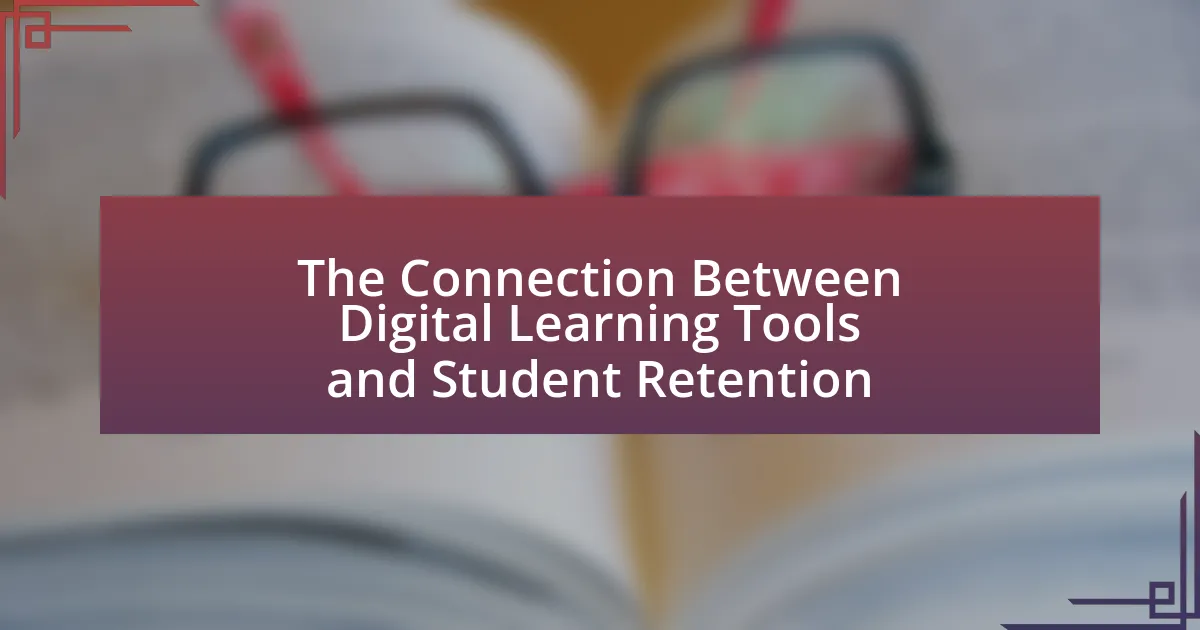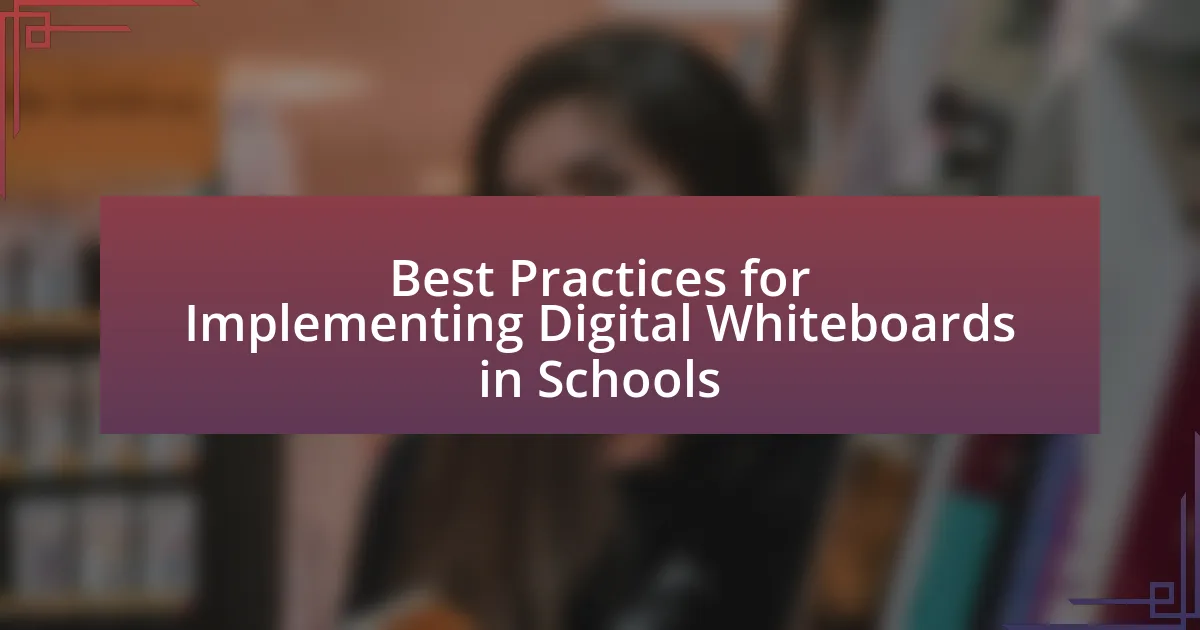Online learning communities are virtual environments that facilitate collaborative learning and knowledge sharing among individuals, often enhanced by technology. This article explores the structure, function, and benefits of these communities, highlighting key components such as collaboration, communication, and resource sharing that enhance the learning experience. It also examines the impact of emerging technologies, demographic shifts, and cultural factors on participation, as well as the challenges and strategies for improving accessibility and engagement. Additionally, the article discusses innovative practices and best practices for creating effective and inclusive online learning environments, emphasizing the importance of community feedback in shaping future developments.

What are Online Learning Communities?
Online learning communities are virtual spaces where individuals engage in collaborative learning and knowledge sharing, often facilitated by technology. These communities enable learners to connect with peers and educators, participate in discussions, share resources, and support each other’s educational journeys. Research indicates that online learning communities enhance student engagement and improve learning outcomes by fostering a sense of belonging and providing diverse perspectives. For example, a study published in the “Journal of Online Learning Research” found that students in online communities reported higher satisfaction and motivation compared to those learning in isolation.
How do Online Learning Communities function?
Online Learning Communities function by facilitating interaction and collaboration among learners through digital platforms. These communities enable members to share resources, engage in discussions, and participate in collaborative projects, enhancing the learning experience. Research indicates that such communities promote peer-to-peer learning, where participants can learn from each other’s experiences and insights, leading to improved knowledge retention and understanding. For instance, a study by the Community of Inquiry framework highlights that social presence, cognitive presence, and teaching presence are critical elements that contribute to effective online learning environments.
What are the key components of Online Learning Communities?
The key components of Online Learning Communities include collaboration, communication, shared resources, and a supportive environment. Collaboration allows members to work together on projects and share knowledge, enhancing the learning experience. Communication facilitates interaction through forums, chats, and video conferencing, fostering relationships among participants. Shared resources, such as articles, videos, and tools, provide valuable materials that enrich learning. A supportive environment encourages participation and engagement, making members feel valued and motivated to contribute. These components are essential for creating effective and engaging online learning experiences.
How do these components enhance the learning experience?
The components of online learning communities enhance the learning experience by fostering collaboration, engagement, and personalized learning. Collaborative tools enable learners to interact and share knowledge, which has been shown to improve understanding and retention of information. For instance, a study by the University of California found that students who participated in collaborative learning environments scored 20% higher on assessments compared to those who learned individually. Engagement is further enhanced through interactive elements such as discussion forums and multimedia resources, which cater to diverse learning styles and keep learners motivated. Personalized learning pathways allow individuals to progress at their own pace, leading to increased satisfaction and better outcomes, as evidenced by research from the Bill & Melinda Gates Foundation, which reported that personalized learning approaches can lead to significant gains in student achievement.
What are the benefits of Online Learning Communities?
Online Learning Communities provide enhanced collaboration, increased access to diverse resources, and improved learner engagement. These communities facilitate peer-to-peer interaction, allowing learners to share knowledge and experiences, which fosters a sense of belonging and motivation. Research indicates that students in online learning communities often achieve higher retention rates and better academic performance due to the support and encouragement they receive from their peers. For instance, a study published in the Journal of Online Learning Research found that participants in structured online communities reported a 20% increase in course completion rates compared to those who studied independently.
How do Online Learning Communities foster collaboration among learners?
Online Learning Communities foster collaboration among learners by providing a structured environment for interaction, knowledge sharing, and peer support. These communities utilize discussion forums, group projects, and collaborative tools that enable learners to engage with one another, share resources, and provide feedback. Research indicates that collaborative learning enhances critical thinking and problem-solving skills, as learners benefit from diverse perspectives and collective knowledge. For instance, a study published in the Journal of Online Learning Research found that students participating in online collaborative activities reported higher levels of engagement and satisfaction compared to those in traditional learning settings. This evidence underscores the effectiveness of Online Learning Communities in promoting collaborative learning experiences.
What role do Online Learning Communities play in skill development?
Online Learning Communities significantly enhance skill development by providing collaborative environments where learners can share knowledge, resources, and experiences. These communities facilitate peer-to-peer interaction, which has been shown to improve understanding and retention of skills through social learning theories. Research indicates that learners engaged in online communities report higher levels of motivation and satisfaction, leading to better skill acquisition. For instance, a study published in the Journal of Educational Psychology found that students participating in online discussion forums demonstrated a 20% increase in skill proficiency compared to those who learned in isolation. This evidence underscores the critical role that Online Learning Communities play in fostering effective skill development.

What trends are shaping the future of Online Learning Communities?
The future of Online Learning Communities is being shaped by trends such as increased personalization, the integration of artificial intelligence, and a focus on community engagement. Personalization allows learners to tailor their educational experiences to their individual needs, enhancing motivation and retention. The integration of artificial intelligence facilitates adaptive learning technologies that provide real-time feedback and customized learning paths. Additionally, a strong emphasis on community engagement fosters collaboration and peer support, which are critical for effective learning. According to a report by the Online Learning Consortium, 70% of students in online learning environments value interaction with peers, highlighting the importance of community in enhancing the learning experience.
How is technology influencing Online Learning Communities?
Technology is significantly influencing Online Learning Communities by enhancing accessibility, engagement, and collaboration among learners. Online platforms enable users to access educational resources anytime and anywhere, breaking geographical barriers and allowing diverse participation. For instance, according to a report by the Online Learning Consortium, 70% of students in online courses reported that technology improved their learning experience through interactive tools such as discussion forums, video conferencing, and collaborative projects. These tools foster real-time communication and peer interaction, which are essential for building a sense of community. Additionally, data analytics in educational technology helps tailor learning experiences to individual needs, further promoting effective learning outcomes.
What emerging technologies are being integrated into Online Learning Communities?
Emerging technologies integrated into Online Learning Communities include artificial intelligence, virtual reality, augmented reality, and blockchain. Artificial intelligence enhances personalized learning experiences through adaptive learning systems that analyze student performance and tailor content accordingly. Virtual reality and augmented reality create immersive learning environments, allowing students to engage in interactive simulations and real-world scenarios, which has been shown to improve retention rates. Blockchain technology is utilized for secure credentialing and verification of achievements, ensuring transparency and trust in the learning process. These technologies collectively contribute to a more engaging, efficient, and secure online learning experience.
How do these technologies improve engagement and interaction?
These technologies improve engagement and interaction by facilitating real-time communication and personalized learning experiences. For instance, platforms that utilize artificial intelligence can analyze user behavior and preferences, allowing for tailored content delivery that resonates with individual learners. Research indicates that personalized learning can increase student engagement by up to 30%, as it aligns educational material with the learner’s interests and needs. Additionally, interactive tools such as discussion forums and live chat features enable immediate feedback and collaboration among peers, fostering a sense of community and enhancing overall participation in online learning environments.
What demographic shifts are impacting Online Learning Communities?
Demographic shifts impacting Online Learning Communities include an increase in older adults seeking education, a rise in diverse cultural backgrounds among learners, and the growing prevalence of remote learning due to geographic mobility. The increase in older adults, particularly those aged 50 and above, reflects a trend where lifelong learning is prioritized, with 43% of adults in this age group expressing interest in online courses, according to a report by the Pew Research Center. Additionally, the diversification of learners, with more individuals from various ethnic and cultural backgrounds participating, enriches the learning environment and necessitates inclusive content and teaching methods. Furthermore, the rise of remote work has led to more individuals seeking flexible learning options, as evidenced by a 2021 survey from the Online Learning Consortium, which found that 70% of respondents preferred online learning due to its convenience and accessibility. These shifts are reshaping the landscape of online learning, making it more inclusive and adaptable to the needs of a broader audience.
How are different age groups utilizing Online Learning Communities?
Different age groups utilize Online Learning Communities in distinct ways, reflecting their unique learning preferences and technological familiarity. Younger learners, such as students in K-12 and college, often engage in these communities for collaborative projects, peer support, and access to diverse resources, leveraging platforms like Discord and Slack for real-time interaction. Adults, particularly professionals, utilize Online Learning Communities for networking, skill development, and continuing education, often participating in webinars and discussion forums on platforms like LinkedIn Learning and Coursera. Seniors increasingly engage with these communities to enhance digital literacy and connect with others, often using platforms designed for ease of use, such as Facebook groups or dedicated online courses tailored for older adults. Research indicates that 70% of younger learners prefer collaborative online environments, while 60% of adults seek professional development opportunities through these platforms, highlighting the varied motivations across age groups.
What cultural factors influence participation in Online Learning Communities?
Cultural factors that influence participation in Online Learning Communities include communication styles, social norms, and values related to education. Communication styles vary across cultures, affecting how individuals engage in discussions and share knowledge; for instance, collectivist cultures may prioritize group harmony over individual expression, leading to different participation dynamics. Social norms dictate acceptable behaviors within these communities, influencing whether individuals feel comfortable contributing or asking questions. Additionally, values related to education, such as the importance placed on lifelong learning or formal qualifications, can significantly impact an individual’s motivation to participate. Research by Chen and Bryer (2012) in “Investigating the Factors Influencing the Participation of Online Learning Communities” highlights that cultural background shapes user engagement and interaction patterns, confirming the relevance of these factors in online learning environments.
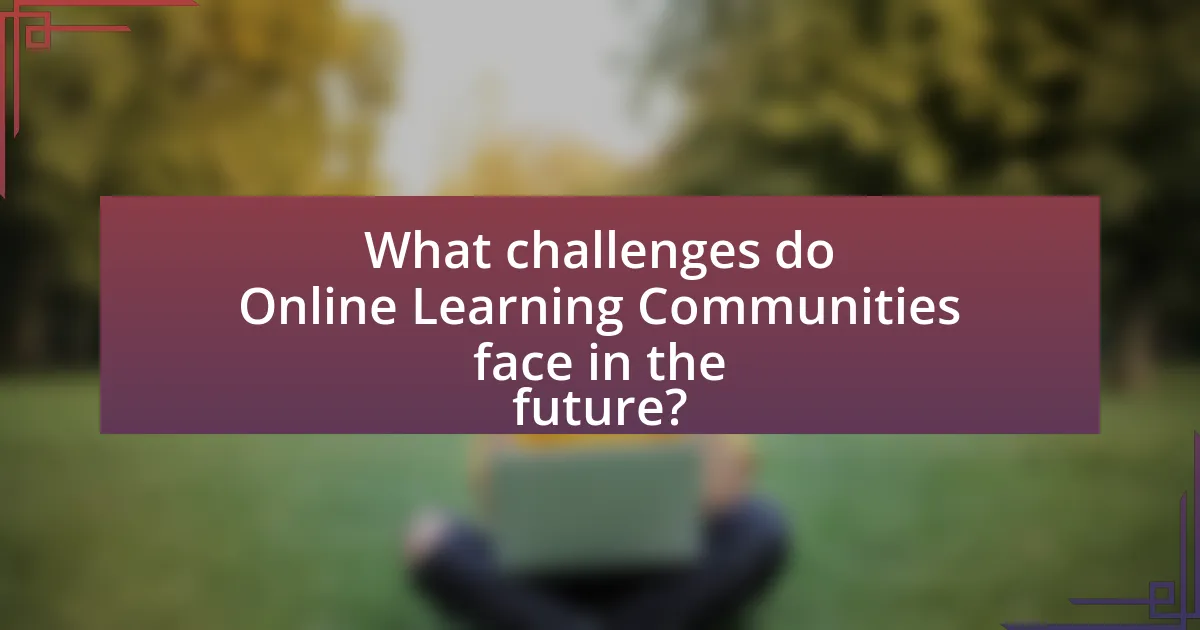
What challenges do Online Learning Communities face in the future?
Online Learning Communities will face challenges such as maintaining engagement, ensuring equitable access, and adapting to technological advancements. Engagement is critical, as studies show that 70% of online learners report feeling isolated, which can hinder their motivation and learning outcomes. Equitable access remains a concern, with the digital divide affecting low-income and rural students, as approximately 15% of U.S. households lack reliable internet access. Additionally, rapid technological changes require continuous adaptation of curricula and teaching methods, as evidenced by the fact that 65% of jobs will require digital skills by 2030. These challenges necessitate strategic planning and resource allocation to foster effective online learning environments.
What are the common barriers to participation in Online Learning Communities?
Common barriers to participation in Online Learning Communities include lack of motivation, technological challenges, and insufficient social interaction. Lack of motivation can stem from unclear learning objectives or perceived irrelevance of the content, leading to disengagement. Technological challenges, such as inadequate internet access or unfamiliarity with digital tools, hinder users from fully engaging. Insufficient social interaction can result from a lack of community building, making participants feel isolated and less inclined to contribute. Research by the Online Learning Consortium indicates that these factors significantly impact user engagement and retention in online learning environments.
How can these barriers be addressed to improve accessibility?
Barriers to accessibility in online learning communities can be addressed through the implementation of universal design principles, which ensure that educational resources are usable by all individuals regardless of their abilities. For instance, incorporating features such as screen reader compatibility, captioning for videos, and alternative text for images significantly enhances accessibility for users with disabilities. Research indicates that 15% of the global population experiences some form of disability, highlighting the necessity for inclusive design (World Health Organization, 2021). Additionally, providing training for educators on accessibility best practices can further mitigate barriers, as informed instructors are better equipped to create inclusive learning environments.
What strategies can be implemented to enhance user retention?
To enhance user retention in online learning communities, implementing personalized learning experiences is crucial. Personalization can be achieved through adaptive learning technologies that tailor content to individual user needs, preferences, and progress. Research indicates that personalized learning can increase engagement and retention rates by up to 30%, as users feel more connected to the material and motivated to continue their learning journey. Additionally, fostering a sense of community through interactive features such as discussion forums, peer feedback, and collaborative projects can significantly improve user retention, as social connections enhance the overall learning experience.
How can Online Learning Communities evolve to meet future needs?
Online Learning Communities can evolve to meet future needs by integrating advanced technologies, fostering personalized learning experiences, and enhancing collaboration among members. The incorporation of artificial intelligence can facilitate adaptive learning pathways tailored to individual student needs, as evidenced by studies showing that personalized learning can improve student engagement and outcomes. Additionally, utilizing virtual and augmented reality can create immersive learning environments that enhance understanding and retention of complex subjects. Collaborative tools, such as discussion forums and project management platforms, can further strengthen community interaction, leading to a more supportive and engaging learning atmosphere. Research indicates that communities with high levels of interaction and collaboration yield better educational results, underscoring the importance of these elements in future online learning frameworks.
What innovative practices can be adopted to enhance learning outcomes?
Innovative practices that can be adopted to enhance learning outcomes include the integration of adaptive learning technologies, collaborative learning environments, and gamification strategies. Adaptive learning technologies personalize the educational experience by adjusting content and assessments based on individual learner performance, which has been shown to improve engagement and retention rates. Collaborative learning environments foster peer-to-peer interaction and knowledge sharing, leading to deeper understanding and critical thinking skills. Gamification strategies, which incorporate game-like elements into learning activities, have been proven to increase motivation and participation, as evidenced by studies indicating that gamified learning can lead to a 50% increase in student engagement.
How can community feedback shape the development of Online Learning Communities?
Community feedback can significantly shape the development of Online Learning Communities by providing insights into user needs and preferences. This feedback allows developers to tailor content, enhance user experience, and foster engagement. For instance, a study by the Online Learning Consortium found that 70% of learners prefer courses that incorporate peer feedback, indicating that community input directly influences course design and delivery. Additionally, regular surveys and discussion forums enable continuous improvement based on real-time user experiences, ensuring that the community evolves in alignment with its members’ expectations.
What best practices should be followed for effective Online Learning Communities?
Effective online learning communities should prioritize clear communication, active engagement, and structured support. Clear communication fosters understanding and collaboration among members, while active engagement encourages participation and knowledge sharing. Structured support, such as providing resources and guidance, enhances the learning experience. Research indicates that communities with these practices see higher retention rates and improved learner satisfaction, as evidenced by a study from the Online Learning Consortium, which found that well-structured online communities can increase student engagement by up to 30%.
How can facilitators create an inclusive environment in Online Learning Communities?
Facilitators can create an inclusive environment in Online Learning Communities by implementing diverse teaching strategies that cater to various learning styles and backgrounds. This includes using multimedia resources, encouraging collaborative projects, and fostering open communication to ensure all voices are heard. Research indicates that inclusive practices, such as differentiated instruction and culturally responsive teaching, enhance engagement and learning outcomes for all participants. For example, a study by the National Center for Learning Disabilities found that inclusive classrooms improve academic performance and social skills among students from diverse backgrounds.
What tools and resources are essential for successful Online Learning Communities?
Essential tools and resources for successful Online Learning Communities include communication platforms, learning management systems (LMS), and collaborative tools. Communication platforms like Slack or Discord facilitate real-time interaction among members, enhancing engagement and community building. Learning management systems, such as Moodle or Canvas, provide structured environments for course content, assessments, and tracking progress, which are crucial for organized learning experiences. Collaborative tools like Google Workspace or Microsoft Teams enable members to work together on projects, share resources, and foster a sense of teamwork. These tools collectively support effective communication, structured learning, and collaboration, which are vital for the success of online learning communities.
